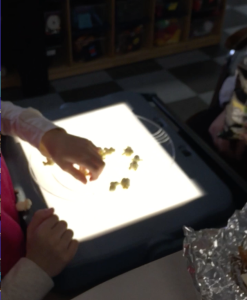As a Teacher of Student with Visual Impairments, I am certainly focused on the improvement of visual skills for my students with CVI. I am also interested in how my students understand everything that is easily understood by their sighted peers due to their incidental learning. These intertwined Expanded Core Curriculum (ECC) areas must be considered for that equal access.
These two important areas of the Expanded Core Curriculum must be considered separately and together. These are:
- Sensory efficiency skills
- Compensatory Skills, Functional Academic Skills (Including Communication Modes)
Sensory Efficiency Skills: This area is especially important for the child with CVI but in a totally different way than that considered for a child with ocular impairments. We are expecting improvement for student with CVI. Functional visual assessment provides the baseline for functional visual skills and sets the stage for this improvement using strategies and objectives matched to the assessed needs.
Compensatory Skills, Functional Academic Skills: This area must be considered to support the building functional vision of the student with CVI. Vision is the distance sense that supports what is heard, smelled, felt and tasted.
Think about a classroom where someone drops something. The child with typical visual abilities can turn, look and determine what made the sound and determine that the sound is not a threat. The student with CVI hears the item drop and due to lack of visual location abilities or lack of distance abilities, does not turn, does not understand what made the sound and might remain in a state of stress wondering if this sound is a threat or not. We need to build this understanding of environmental sounds by labeling the sound, bringing the child closer to the sound, bringing the sound to them and allowing them to make the sound themselves for complete understanding. If someone drops a tray in the classroom, I make sure to bring a tray to the child and allow them to see it, feel it and push it off the tray to create the sound. Once understood, the sound will not create stress and allow the child to return to the learning. This approach provides the student with the same access to the visual, auditory, tactile, cognitive/language information enjoyed by their sighted peers.
For functional academics, focus needs to consistently be on ways to create and foster the highest level of independence possible to live and work in the future. These are skills that should be worked on from birth! Think of the value of organizational skills for a child with limited visual abilities. Getting objects from a storage place and returning the item to that store place when completed builds independence and understanding of the student’s environment.
For communication the CVI assessment can help us determine whether we provide tactile sign language to the student with deafblindness or just visually presented sign. If the child is only using peripheral vision, they could never see and understand the small, distinct visual-only sign that requires central vision use. If a communication device is used, the CVI assessment provides information about the accessibility of pictures, the ability to recognize pictures, the number of items that can be seen and recognized at one time (complexity of array), and what size is needed (due to complexity not acuity!). For literacy and communication, the CVI assessment provides information about the unique need for color highlighting, spacing and print size (due to complexity not acuity!)
All students with visual impairments need the ECC considered and provided in their educational programming. Students with CVI have the same educational needs but with consideration that CVI is completely different from ocular impairments.

